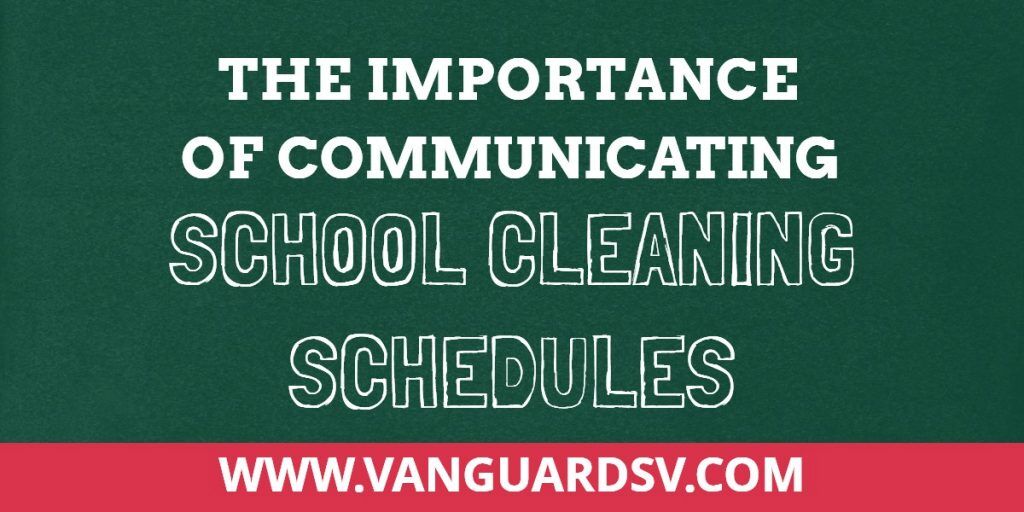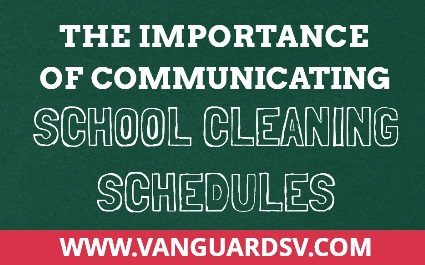Effective communication of school cleaning schedules with teachers and staff will reduce stress, eliminate the potential for the damage of teacher purchased school supplies, and improve the efficacy of the cleaning program.

Why Effective Communication of School Cleaning Schedules is Important
The impact of poorly executed cleaning programs on students, teachers, and staff have been well documented, specifically in the areas of costs associated with absenteeism as well as performance issues tied to low-quality indoor air and the ongoing exposure to germs and bacteria.
However, as evidenced by a recent incident involving Chicago area schools that received a dismal health and cleanliness review that led to the direct involvement of Chicago Public Schools (CPS), poor communication of cleaning schedules and required tasks, as well as room and facilities access only makes matters worse.
According to an account of the custodial supplier's poor response;
Teachers unable to respond quick enough found books strewn across the library and materials scattered.
Many teachers at the school — which serves low-income students — had purchased materials with their own money and now found themselves reassembling their classrooms.
CPS officials stress that the cleaning efforts were well intended, but poor communication regarding the cleaning schedule [led to] "the host of issues that the school community experienced."
The Cost and Consequence of Unhealthy Schools
Unhealthy schools carry massive unnecessary costs and adversely affect the health and performance of students and teachers.
The accumulation of germs passed from students to teachers has been shown to cost U.S. schools and taxpayers billions of dollars per year.
The Center for American Progress estimates that 5.3 percent of teachers in the United States are absent on any given day, which translates to a minimum of $4 billion in extra costs for substitute teachers and additional administrative costs.
Combating the challenge of absenteeism is not an easy one, but much of it starts with a thorough process for cleaning each of your schools.
Your cleaning partner needs to give the same kind of attention to the water fountain as they give the toilet seats, and communication between the crew and your staff is paramount to success.
Teacher absenteeism is hugely relevant and has been shown to have a direct carryover to the quality of education received by the students.
A recent study conducted by researchers at Harvard University reported a significant deviation in fourth-grade student performance in English-Language Arts and Mathematics when teachers were reported as absent for 10 or more days.
Their evidence indicates that 10 additional days of teacher absences decreased student achievement by 1% or 2% of a standard deviation.
Do Teacher Absences Impact Student Achievement? Longitudinal Evidence From One Urban School District
Germs combined with low-quality indoor air--a byproduct of poor ventilation and various chemicals used in the classroom, including commercial cleaning products--contribute to numerous health issues that negatively impact learning.
A recent study found that students in classrooms with greater ventilation scored as much as 14 to 15 percent higher on standardized tests than those in classrooms with less ventilation.
Concentration and attention span are both improved in interior spaces with good indoor air quality.
Absenteeism is another effect that’s been associated with the condition of school buildings.
One study in New York State looked at the physical condition of the school building and there was a strong correlation between school absenteeism rates and poor building conditions.
Want to Improve Student Performance? Start with the Air They Breathe
From these studies, we can extrapolate that higher-quality cleaning and sanitation practices combined with improved indoor air quality reduce unnecessary financial waste while improving the learning environment, leading to enhanced student performance and a higher likelihood of graduation.
This leaves the challenge of identifying critical areas of germ transference and how best to communicate classroom and facility cleaning schedules to address those areas without disrupting the teacher's plans or the students' learning environment.
Where Germs are Commonly Found in Schools
Germs and bacteria are everywhere in schools--most commonly:
- Water fountain spigots in the classroom and cafeteria.
- Cafeteria plates and trays.
- Water faucet handles.
- Computer keyboards in the classroom, and;
- Toilet seats.
More importantly, they are found on the hands of students due to poor hand-hygiene--a challenge being faced by school districts across the country.
Due to the steady flow of contagious students and the high-contact nature of many of the items commonly covered in germs, sanitation and disinfection alone are insufficient to adequately address the challenge--underscoring the importance of regular hand washing before eating, after recess, and using the restroom.
Since bacteria and viruses can live for more than two days on many surfaces, it’s important to protect yourself.
And the best way is through proper and frequent handwashing.
Proper handwashing involves thorough scrubbing of hands under warm water with soap for a full 20 seconds before rinsing and drying with a clean towel.
Efficiently Communicating Needs and Access Requirements
While the Chicago school district incident is an extreme example, it does highlight several key areas that should be addressed when cleaning classrooms and other educational facilities.
The first of which is detailing access to rooms, as well as locked or otherwise secured areas that can harbor germs, pests, dust, and bacteria.
This will help ensure that no locks are cut and that educational materials, especially those purchased by teachers, are protected.
Documenting and communicating the need to access secured areas in a timely fashion also relieves a great deal of stress on staff and instructors--allowing them sufficient time to respond to the request and eliminating a great deal of potential tension and resistance.
The next step is to detail the process that the custodial team will employ to enter, survey, clean, disinfect, and ventilate each area, as well as expected times of entry and estimated times of completion.
This allows for instructors and staff to adequately plan around certain tasks and establishes realistic expectations on the part of district supervisors.
Additionally, the types of chemicals used during the cleaning process, as well as their potential side-effects, should be explained to parents and faculty to ensure any fears are addressed and reasonable precautions are employed.
The medium by which this information is communicated is not really relevant.
However, the communication can only be considered effective if the plan allows enough time for full dissemination and discussion.
References & Resources
- Chicago Schools Debate Use Of Private Janitors
- Teacher Absence as a Leading Indicator of Student Achievement
Takeaway
Green cleaning and disinfection practices combined with improved indoor air quality has been shown to decrease student and teacher sick days while improving performance--leading to a statistically higher likelihood of graduation.
However, regardless of how well-intentioned any cleaning program is, the process must be thoroughly communicated to all relevant parties for it to be sustainably successful.
If you would like to learn more regarding the benefits of effective communication and scheduling for your school cleaning services, or the benefits of introducing green and sustainable cleaning practices for your disctrict–contact us today for a free quote!
In Bakersfield CA, call (661) 4373253
In Fresno CA, call (559) 206-1059
In Valencia CA, or Santa Clarita CA, call (661) 437-3253

